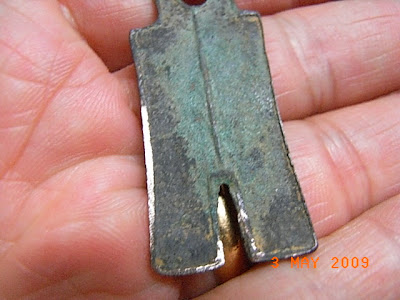

 Here I have decided to give you an actual check on the authentic of the material content of these coins.
Here I have decided to give you an actual check on the authentic of the material content of these coins.Certainly, these check cost money loss.
I have decided to use one of my collection to do an experiment test on the material of the coin to proves its authenticity.
It is a very simple testing method if you are willingly to sacrifice your coin worthiness.
Test Method 1: Check its purities of material content. Look out for any mixtues of composition.
The benchmark : Bronze material.
1.1 Wash away the dirt on the surface.
1.2 Compare the surface of Patina coating.
Result: The surface after washing will loss the Patina coating. Only those thick patina will remained. The background of the surface look "black" color because of bronze content present.
Note: IF YOU'RE NOT DOING FOR EXPERIMENT TEST: DO NOT WASH THE COIN OR CLEAN AWAY THE SOIL IN THE COIN. THIS DESTROYED THE AUTHENTICITY.WASHING OR CLEANING AWAY THE SOIL AND PATINA COATING WILL DEVALUE THE COIN ANTIQUE VALUE & WORTHINESS.
Test Method Nos. 2: Magnetic Test
2.1 Use a strong magnet to test on the coin.
2.2 Check whether is there any Steel or Iron material present content.
The benchmark: The coin is PURE BRONZE material by original.
There shouldn't be any Iron or Steel content present in the coin material.
It has to be pure Bronze material content.
2.3 Use the magnet to stick test on the coins whether it stick to magnet?
If it stick to magnet. It prove that the coin is not bronze coin.
What material contents made of during Shang ; Zhou; Qin;Han period?
The basic material of coin made of bronze material. Because it is a bronze age era in which bronze material is the main raw material for making utensils and ornament like coins and morror and vessels.
Therefore,Wang Mang coins ; Knife coins; Sabre coins has to be made from bronze material. Pure Bronze coins does not stick to the magnet.
The result of my coins : Pure Bronze. Refer to my photo taken on 3rd May-2009
What material does today coin made of?
USA Quarters coin, dimes, and half dollars are cupro-nickel clad. Each coin has a copper core and an outer layer, the “clad,” made of 75 percent copper and 25 percent cupro-nickel alloy. Nickels are made from the same 75-25 alloy.
The Golden Dollar is also a clad coin. The alloy layers on each side of the copper core are manganese brass, a golden-colored material composed of 77% copper, 12% zinc, 7% manganese, and 4% nickel.
The One cent coin, was once made of copper coin, is now composed of copper-plated zinc. Copper-plated cents cost less to manufacture, and at 2.5 grams each, they weigh about 20% less than the older cent, which was 95 percent copper and 5 percent zinc.
Coin made from my own country SINGAPORE
The old series was made with a mixture of Copper-clad -steel & Cupro-Nickel-clad-Steel
The current series coins now made of:
10 cent; 20 cents; 50 cents : CuproNickel
5 cents & 1$ coin: AlumBronze
1 cent: Cupper-plated Zinc
Do you know your country series of coins made of what material?
You can test it out easily by using the same methods I applied using method 2 & 3.
Test Method Nos. 3 In-depth test on inside the surface
3.1 This is the final test on material which will devalue the coin antique value.
3.2 Use a precision file tool to file out the external coating on the surface.
Note: Once you file into the inner surface of the coin, you will see the inner depth of the material.
This is the most convincing to prove the authenticity of the coin.
3.3 You will see the inner depth of the coin material. The bronze should be seen visible & clear.
Refer to my photo taken on 3rd May-2009.
Note: Again, This filing method will damage the coin surface. The filing will cause the coin devalue........Meaning the coin become less antique value.
Conclusion: IF you don't wish to damage your coin aand cause devalue of your coin. It is recommended to use my Method Test No. 4 which is the most simple and Zero Risk to the damage and devalue.
Test Method Nos. 4
4.1 Use the Antique Coin Blue-print guide book
4.2 Place your coin to the blue-print to fit in and match the coin with the blue-print.
If it is the authentic coin, it should match and fit the blue-print.
4.3 Then another check is to use the Magnet Test to ensure it does not have Steel or Iron content in the coin.
Conclusion: Are you willing to give up one of your coin to test it?
Now, my this coin may be worth only US$125..........But it is worth a test to teach new collectors and researchers how to understand the way to study Ancient China Coins. I may have to look for another 700 HuoBu coin to replace this coin I have tested. But it is a worthy test.





No comments:
Post a Comment